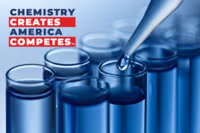Chemistry is foundational to economic growth and innovation, supporting nearly every corner of the economy from agriculture and national defense to clean energy, life-saving medical devices, and cell phones.
As the global economy grows and prospers, so will demand for chemicals. According to data from the Independent Commodity Intelligence Services (ICIS), demand for chemicals1 is expected to increase by 30% over the next decade. Much of that growth will be in emerging economies where millions of consumers will be transitioning into a middle-class lifestyle.
In the United States (U.S.), chemical demand is expected to grow by nearly 15% by 2033, driven in large part by new manufacturing capacity and infrastructure investment incentivized by recent once-in-a generation legislation, including the Inflation Reduction Act, the Bipartisan Infrastructure Law, and the CHIPS Act. More than 80% of basic and specialty chemicals are consumed by the industrial sector, and these new laws have helped increase demand for these chemicals. In addition, manufacturing is returning to the U.S. as post-COVID disruptions brought into focus the need for shorter supply chains.

To support the growing demand for chemistry products in the U.S., manufacturers are investing in new production to make the innovative chemistries needed to produce clean energy, semiconductors, and other manufactured goods and building products. American manufacturing depends on a robust supply chain for thousands of chemistries and U.S. chemical capacity is expected to grow 10% over the next decade, less than the expected 15% growth in demand.
But capacity is growing substantially in other parts of the world. In China, already the world’s largest chemical producer, capacity is expected to grow by more than a third while demand is only expected to grow by 27%. To the extent that China, buffeted by economic headwinds, cannot consume what it makes, it will look to export markets to fill the gap.
A competitive domestic chemical industry is vital to U.S. manufacturing supply chains and for supporting national priorities. To do this and stay competitive in the global market, a sensible regulatory environment is imperative. The recent surge in misguided regulatory restrictions and a lack of coordination among federal agencies is handicapping the ability to develop and make chemicals here at home. For instance, a survey of ACC member companies found that 70% of chemical manufacturers decided to introduce new chemicals produced outside of the U.S. Unfortunately, far too often policies have been made in a vacuum, not accounting for the ripple effects restricting chemical production can have on manufacturing, the availability of everyday products, and across the broader economy. And even national priorities set by the Biden Administration.
For example, in April, the EPA issued a new rule to cut air pollution by lowering the “safe” level of exposure for a chemical used to produce semiconductors and electric vehicles. However, the agency defines that threshold as 23,000 times lower than naturally occurring levels in the human body.
That means on the one hand the government is spending hundreds of billions of dollars to facilitate domestic semiconductor production while on the other hand is issuing policies that are making it much harder to produce them. It takes as many as 500 specialized chemicals to manufacture semiconductors. Many of these chemicals are subject to new government restrictions that massively raise compliance costs for the companies producing them. With the U.S. set to triple its semiconductor manufacturing capacity in the next decade, it is more important than ever for the administration to develop well thought out policies that do not conflict with each other.
That’s why the Office of Management and Budget (OMB) should work closely with chemical industry experts to study these complex interdependencies and ensure they are reflected in policy. Legislation could also help. In May, a bipartisan coalition in Congress introduced the Regulatory Early Notice and Engagement Act. This bipartisan bill would inject much-needed transparency into the regulatory process by requiring that federal agencies establish a robust public need for chemical regulations.
The U.S. is at a crossroads. America needs to adopt smarter, pro-growth policies that support domestic chemical manufacturing to meet the growing demand, strengthen its competitive edge, and protect the nation’s trade balance.
1 ACC used data from the ICIS Supply and Demand database to look at trends across a basket of 14 chemical products, including ethylene, propylene, butadiene, benzene, toluene, paraxylene, methanol, styrene, ethylene glycol, ethylene oxide, polyethylene, polypropylene, polystyrene, and polyvinyl chloride. Together, these chemicals represent the majority of basic chemical production (excluding inorganics).




